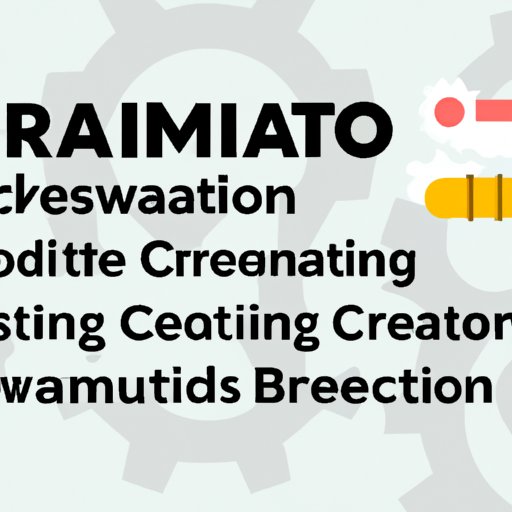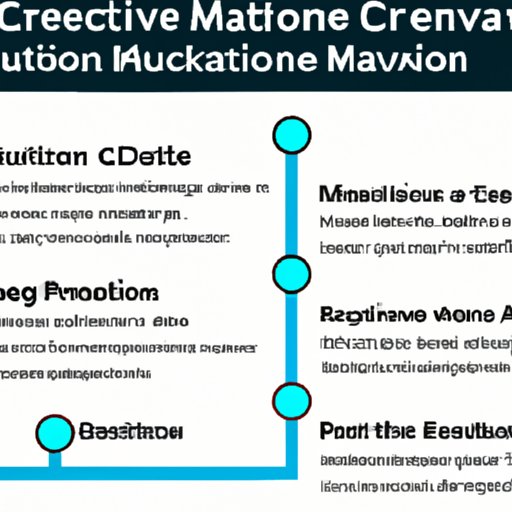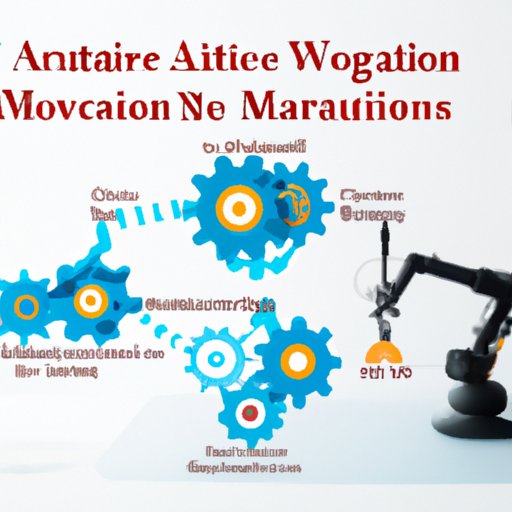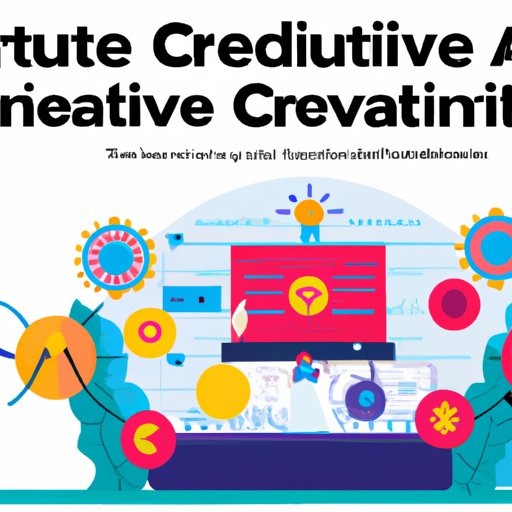Introduction
Creative automation is a rapidly evolving field of technology that is transforming the way businesses approach creative tasks. By automating the creative process, businesses can save time and resources while still producing high-quality work. In this article, we’ll explore what creative automation is, how it works, its key features and capabilities, and its potential uses in different industries.

Exploring the Basics of Creative Automation: What it is and How it Works
At its core, creative automation is a set of tools and technologies that automate the creative process. It enables businesses to quickly and efficiently produce high-quality creative work without requiring manual labor or long production times. Creative automation can be applied to many different types of creative tasks, including web and graphic design, video editing, animation, and more.
Creative automation is powered by a combination of artificial intelligence (AI) and machine learning algorithms. These algorithms are designed to recognize patterns in data, which they then use to generate original content. For example, in web design, AI algorithms can analyze user behavior and generate content that is optimized for a particular user’s needs. Similarly, in video editing, AI algorithms can identify patterns in footage and automatically create a professional-looking video.
In addition to AI and machine learning algorithms, creative automation also relies on natural language processing (NLP) and computer vision. NLP enables computers to understand and respond to human language, while computer vision allows computers to “see” and interpret visual data. Together, these technologies enable computers to autonomously generate creative work that is both accurate and aesthetically pleasing.
There are numerous benefits to utilizing creative automation in business. For starters, it increases efficiency by eliminating the need for manual labor. As a result, businesses can complete projects faster and with fewer resources. Additionally, creative automation can improve the quality of creative work by ensuring accuracy and consistency across projects. Finally, creative automation can lead to significant cost savings by reducing the amount of time and money spent on creative tasks.
The Benefits of Utilizing Creative Automation in Business
Utilizing creative automation in business offers numerous advantages. The most significant of these benefits include increased efficiency, improved quality, and cost savings.
One of the primary benefits of using creative automation is increased efficiency. By automating the creative process, businesses can reduce the amount of time and effort required to complete projects. This increased efficiency can lead to faster turnaround times and reduced labor costs. Additionally, businesses can use creative automation to streamline their processes and increase their productivity.
Another benefit of creative automation is improved quality. By leveraging AI and machine learning algorithms, businesses can ensure that their creative work is accurate and consistent. This can help them stand out from the competition and attract more customers. Furthermore, creative automation can help businesses create more personalized experiences for their customers by providing highly targeted content.
Finally, creative automation can lead to significant cost savings. By automating the creative process, businesses can reduce the amount of time and money they spend on creative tasks. This can free up resources that can then be used to invest in other areas of the business.

Creative Automation: A Breakdown of Its Key Features and Capabilities
Creative automation has several key features and capabilities that make it a powerful tool for businesses. These features include automated storytelling, automated design, and automated content creation.
Automated storytelling refers to the ability to automatically generate stories based on data. By analyzing user behavior, AI algorithms can generate stories that are tailored to a specific audience. This can help businesses create engaging content that resonates with their target audiences.
Automated design is another key feature of creative automation. This feature allows businesses to quickly generate high-quality designs without the need for manual labor. By leveraging AI and machine learning algorithms, businesses can automatically generate designs that are tailored to the needs of their customers.
Finally, automated content creation is a key capability of creative automation. This feature enables businesses to quickly generate content that is optimized for search engine optimization (SEO). By leveraging AI algorithms, businesses can create content that is both engaging and optimized for SEO.
Creative Automation: A Step-by-Step Guide to Implementing It
Implementing creative automation can be a daunting task. However, by following a few simple steps, businesses can successfully implement creative automation into their processes. The steps to implementing creative automation include establishing goals, analyzing data, creating a plan, and implementing creative automation.
First, businesses should establish clear goals for their creative automation efforts. This will help them determine what type of creative work they want to automate and what results they hope to achieve. It will also help them create a timeline for implementation.
Next, businesses should analyze data to identify patterns and trends. This will help them determine which aspects of the creative process are most suitable for automation. Additionally, businesses should consider the potential impact of creative automation on their current processes.
Third, businesses should create a plan for implementing creative automation. This plan should outline the steps needed to successfully implement creative automation and the resources required to do so. It should also include a timeline for completion.
Finally, businesses should implement creative automation. This includes selecting the right tools and technologies and training staff on how to use them. Additionally, businesses should monitor the performance of their creative automation efforts to ensure they are achieving the desired results.
Analyzing the Potential Uses for Creative Automation in Different Industries
Creative automation has the potential to revolutionize the way businesses approach creative tasks. By automating the creative process, businesses can save time and resources while still producing high-quality work. Here, we’ll examine the potential uses for creative automation in different industries.
In the retail industry, creative automation can be used to create personalized shopping experiences. By leveraging AI algorithms, retailers can generate product recommendations that are tailored to a customer’s individual needs. Additionally, creative automation can be used to generate targeted marketing campaigns that are optimized for maximum effectiveness.
In the healthcare industry, creative automation can be used to create personalized patient care plans. By analyzing patient data, AI algorithms can generate treatment plans that are tailored to an individual’s medical history. Additionally, creative automation can be used to generate personalized health education materials that are optimized for a particular patient’s needs.
Finally, in the education sector, creative automation can be used to create personalized learning experiences. By leveraging AI algorithms, educators can generate content that is tailored to a student’s individual learning style. Additionally, creative automation can be used to generate interactive educational materials that are optimized for maximum engagement.

Examining the Impact of Creative Automation on Traditional Creative Processes
Creative automation has the potential to revolutionize traditional creative processes. Here, we’ll examine the potential impact of creative automation on these processes.
One of the primary impacts of creative automation is shortened production times. By automating the creative process, businesses can significantly reduce the amount of time required to complete projects. This can lead to faster turnaround times and reduced labor costs.
Additionally, creative automation can enhance collaboration between teams. By leveraging AI algorithms, teams can quickly and easily share ideas and feedback. This can lead to better communication and improved collaboration.
Finally, creative automation can lead to increased personalization. By leveraging AI algorithms, businesses can generate content that is tailored to a customer’s individual needs. This can help businesses create more engaging and personalized experiences for their customers.
Investigating the Future of Creative Automation: What’s Next?
Creative automation is an emerging field of technology that is rapidly evolving. Here, we’ll examine some of the potential developments in the field of creative automation.
One of the most exciting developments in the field of creative automation is AI-driven creative automation. By leveraging AI algorithms, businesses can create content that is tailored to a customer’s individual needs. Additionally, AI-driven creative automation can enable businesses to quickly and easily generate personalized experiences for their customers.
Another development in the field of creative automation is automated creative workflows. This technology enables businesses to quickly and easily create and manage creative workflows. This can help businesses streamline their processes and increase their productivity.
Finally, augmented reality experiences are becoming increasingly popular. By leveraging AI algorithms, businesses can create immersive augmented reality experiences that engage customers and drive sales. Additionally, augmented reality experiences can be used to generate personalized experiences for customers.
Conclusion
In conclusion, creative automation is an emerging field of technology that has the potential to revolutionize traditional creative processes. It enables businesses to quickly and efficiently produce high-quality creative work without requiring manual labor or long production times. Additionally, creative automation can lead to significant cost savings by reducing the amount of time and money spent on creative tasks. As the technology continues to evolve, businesses should take advantage of its potential to revolutionize their creative processes.
(Note: Is this article not meeting your expectations? Do you have knowledge or insights to share? Unlock new opportunities and expand your reach by joining our authors team. Click Registration to join us and share your expertise with our readers.)
